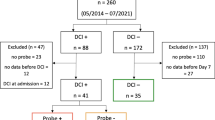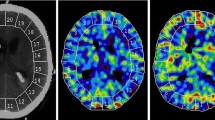Summary.
Summary.
Background:
Arterial vasospasm after subarachnoid hemorrhage may cause cerebral ischemia. Treatment with hemodilution, reducing blood viscosity, and hypervolemia, increasing cardiac performance and distending the vasospastic artery, are clinically established methods to improve blood flow through the vasospastic arterial bed.
Method:
Eight patients with transcranial Doppler verified vasospasm after subarachnoid hemorrhage were investigated with global (two-dimensional 133Xenon) and regional (three-dimensional 99 mTc-HMPAO) cerebral blood flow (CBF) measurements, before and after 1/iso- and 2/hypervolemic hemodilution. Hematocrit was reduced to 0.28 from 0.36. Hypervolemia was achieved by increasing blood volume by 1100 ml.
Findings:
Isovolemic hemodilution increased global cerebral blood flow from 52.25±10.12 to 58.56±11.73 ml * 100 g−1 * min−1 (p<0.05), but after hypervolemic hemodilution CBF returned to 51.38±11.34 ml * 100 g−1 * min−1. Global cerebral delivery rate of oxygen (CDRO2) decreased from 7.94±1.92 to 6.98±1.66 ml * 100 g−1 * min−1 (p<0.001) during isovolemic hemodilution and remained reduced, 6.77±1.60 ml * 100 g−1 * min−1 (p<0.001), after the hypervolemic hemodilution. As a test of the hemodilution effect on regional CDRO2 an ischemic threshold was defined as the maximal amount of oxygen transported by a CBF of 10 ml * 100 g−1 * min−1 at a Hb 140 g/l which corresponds to a CDRO2 of 1.83 ml * 100 g−1 * min−1. The brain volume with a CDRO2 exceeding the ichemic threshold was 1300±236 ml before intervention. After isovolemic hemodilution the non-ischemic brain volume was reduced to 1206±341 (p<0,003). After hypervolemic hemodilution the non-ischemic brain volume remained reduced at 1228±347 ml (p<0.05).
Interpretation:
The present study of controlled isovolemic hemodilution demonstrated increased global CBF, but there was a pronounced reduction in oxygen delivery capacity. Both CBF and CDRO2 remained decreased during further hypervolemic hemodilution. We conclude that hemodilution to hematocrit 0.28 is not beneficial for patients with cerebral vasospasm after SAH.
Similar content being viewed by others
Author information
Authors and Affiliations
Additional information
Published online July 18, 2002
Rights and permissions
About this article
Cite this article
Ekelund, A., Reinstrup, P., Ryding, E. et al. Effects of Iso- and Hypervolemic Hemodilution on Regional Cerebral Blood Flow and Oxygen Delivery for Patients with Vasospasm after Aneurysmal Subarachnoid Hemorrhage. Acta Neurochir (Wien) 144, 703–713 (2002). https://doi.org/10.1007/s00701-002-0959-9
Issue Date:
DOI: https://doi.org/10.1007/s00701-002-0959-9




